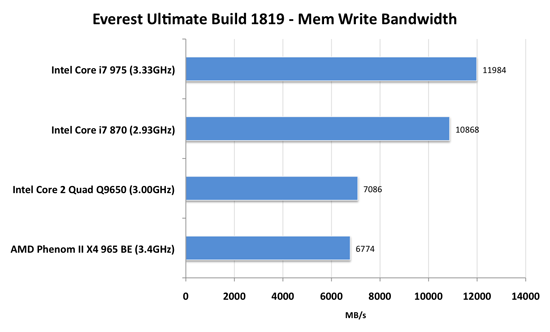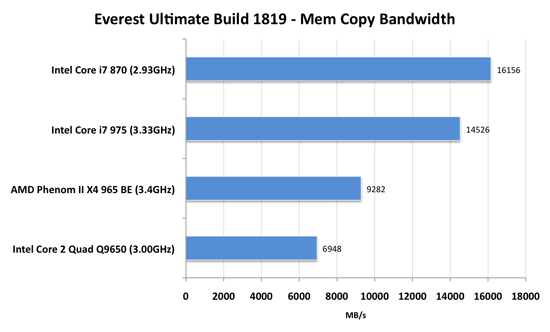Intel's Core i7 870 & i5 750, Lynnfield: Harder, Better, Faster Stronger
by Anand Lal Shimpi on September 8, 2009 12:00 AM EST- Posted in
- CPUs
Discovery: Two Channels Aren't Worse Than Three
Intel told me something interesting when I was out in LA earlier this summer: it takes at least 3 cores to fully saturate Lynnfield's dual-channel DDR3-1333 memory bus. That's three cores all working on memory bandwidth intensive threads at the same time. That's a pretty stiff requirement. In the vast, vast majority of situations Lynnfield's dual channel DDR3 memory controller won't hurt it.
Move up to 6 or 8 core designs and a third memory channel is necessary, and that's why we'll see those processors debut exclusively on LGA-1366 platforms. In fact, X58 motherboards will only need a BIOS update to work with the 6-core 32nm Gulftown processor next year. P55 looks like it'll be limited to four cores and below.
Because of this, Lynnfield's memory bandwidth and latency cores are actually quite similar to Bloomfield. I used Everest to look at memory bandwidth and latency between a Core i7 975 and Core i7 870 (Lynnfield):

Lynnfield's memory controller is good, easily as good as what's in Bloomfield if not slightly better.



Both processors turbo'd up to 3.46GHz, indicating that Everest's memory test uses no more than two threads. The 975 ran DDR3-1066 memory (the highest it officially supports), while the 870 used DDR3-1333. The faster memory gave the 870 the advantage. Since we're not taxing all four cores, Lynnfield is at no disadvantage from a bandwidth perspective. Surprisingly enough, even SiSoft Sandra (which does use four cores for its memory bandwidth test) shows Lynnfield's dual-channel DDR3-1333 memory controller as equal to Bloomfield's triple-channel DDR3-1066 interface.
| SiSoft Sandra 2009.SP4 | Intel Core i7 975 | Intel Core i7 870 |
| Aggregate Memory Bandwidth | 17.8 GB/s | 17.3 GB/s |
Long story short? Lynnfield won't be memory bandwidth limited with DDR3-1333 for the overwhelming majority of usage cases.










343 Comments
View All Comments
Jamahl - Tuesday, September 8, 2009 - link
Digusting! How much money did intel bung you for this disgrace?strikeback03 - Tuesday, September 8, 2009 - link
How is that disgusting? It is the stock configuration of the processor. They are not doing all this testing as an e-pissing contest of who has better performance per clock, it is a comparison of retail products in real-world applications. If (and according to the review, when) AMD has something similar, I'd imagine they will test with that turned on too.Jamahl - Tuesday, September 8, 2009 - link
Why not benchmark the Phenom 2 with fusion for gaming anand???Gary Key - Tuesday, September 8, 2009 - link
"Why not benchmark the Phenom 2 with fusion for gaming anand??? "Have you actually tried using Fusion with Windows 7 x64? It is a total mess. I will be happy to show some results with it, most will say DNF, but that might not make you happy. ;) That said, AMD is working on it, especially trying to get it to play nice with AOD.
In the meantime, here is the current list of items to watch out for - http://game.amd.com/us-en/drivers_fusion.aspx?p=3&...">http://game.amd.com/us-en/drivers_fusion.aspx?p=3&... .
Jamahl - Tuesday, September 8, 2009 - link
What? It's AMD's fault that an unreleased 64-bit os is causing issues with their software?How many people are using Window 7 64 bit who visit this website?
Gary Key - Tuesday, September 8, 2009 - link
It is just as bad in 64-bit Vista. I imagine a fair amount of people that visit the site are using the RTM version of Win7.Jamahl - Tuesday, September 8, 2009 - link
were you benchmarking a processor at 2.66 gigahertz or a processor at 3.2 gigahertz?Gary Key - Tuesday, September 8, 2009 - link
Do you and SnakeOil live in the same house or is the IP address just that similar? LOL.. The processors were benched as they come out of the box. For Lynnfield that means turbo was on as we stated in the article and here in the comments. For Bloomfield, that also means turbo was on, just as it comes out of the retail box.If you check all the other reviews on the web at the main sites, everyone tested with turbo on in the primary benchmarks. So I guess you can say there is a huge conspiracy between us to actually utilize the processors as Intel intended for the users.
Apparently, we all failed at covering it up, so congratulations on discovering the Freeturbomasons. A now not so secret fraternal organization bent on world domination through the use of turbo frequencies inside processors carrying the blue "i" logo.
For the AMD Phenom II x4 series, they were benched with all cores enabled just as they come out of the box, even though you can disable each core in the BIOS just like you can disable turbo on the i7/i5. I guess to make things fair, we should disable the cores on the 965 BE as having that "feature" turned on is cheating.
Anyway, thanks for making my day, I needed some much deserved laughter. :)
Chlorus - Tuesday, September 8, 2009 - link
Seeing as how Fusion isn't even out yet, that would be hard to do...go troll somewhere else. What is with the idiots coming out of the woodwork on this post? You've got the standard fanboys, as well as insecure LGA-1366 owners who feel the need to defend their purchase, and insecure purchasers of 1156 products who are afraid their choice might be bested in a benchmark somewhere.Roland00 - Tuesday, September 8, 2009 - link
Would you please rerun page 9 with an overclocked 975 and the 870. I am wondering how much the difference will grow when the gpus are fed more information due to the faster cpus. Something like 3.8 to 4.0 ghz on both cpus with turbo off (a good overclock yet not in the unreasonable area)If you are investing 400+ dollars in gpus, and you are building it yourself you are probably going to overclock.